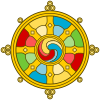Lobsang Yeshe, 5th Panchen Lama

| Part of a series on |
| Tibetan Buddhism |
|---|
 |
Lobsang Yeshe (Tibetan: བློ་བཟང་ཡེ་ཤེས་, Wylie: Blo-bzang Ye-shes, ZYPY: Lobsang Yêxê; also written Lobsang Yeshi) (1663–1737) was the fifth Panchen Lama of Tibet.
He was born of a well-known and noble family in the province of
He received novice vows when he was 8 (9 by Western reckoning) in
When he was thirty-two (in 1696 or 1697), he sent a congratulatory deputation to Beijing. The Kangxi Emperor (1662-1723) invited him to Beijing, but he asked to be excused for fear of smallpox.[2]
The Regent,
In 1701, Lhasang Khan, a Mongol king and ally of the Chinese, had the Regent, Sangye Gyatso, killed. This greatly upset the young Dalai Lama who left his studies who even visited Lobsang Yeshe, the 5th Panchen Lama in Shigatse and renounced his novice monk vows.[4]
In 1713, he received a letter written in three different languages, Tibetan, Mongol and Manchu in gold from the
The 7th Dalai Lama was enthroned in the Potala Palace in 1720. He took the novice vows of monk-hood from the 5th Panchen Lama Lobsang Yeshi, who gave him the name
In 1728, the Yongzheng Emperor (1723-1736) sent Aliha Ampan to settle the border between the provinces of U and Tsang. There was a civil war at this time, and the Chinese asked the Panchen Lama if he would rule all the territories between Khambala and Mount Kailash. The Panchen Lama refused a few times on the grounds of old age but was finally convinced to take control of the whole of Tibet lying to the west of Panam, and relinquished possession of Phari, Gyantse, and Yardosho and other places to the government in Lhasa.[7]
He wrote eighteen volumes of hymns and precepts and died at the age of 75 (74 by Western reckoning), in 1737.
A gilt copper domed tomb, like that of his predecessor, only larger was built for him.
References
- ^ Dás, Sarat Chandra (1882). "The Lives of the Panchen Lamas". Reprinted in: Contributions on the Religion and History of Tibet, p. 118. (1970). Manjusri Publishing House, New Delhi.
- ^ Dás, Sarat Chandra (1882). "The Lives of the Panchen Lamas". Reprinted in: Contributions on the Religion and History of Tibet, p. 118. (1970). Manjusri Publishing House, New Delhi.
- ^ "The Sixth Dalai Lama TSEWANG GYALTSO." Archived 2007-06-10 at the Wayback Machine
- ^ "The Sixth Dalai Lama TSEWANG GYALTSO." Archived 2007-06-10 at the Wayback Machine
- ^ Dás, Sarat Chandra (1882). "The Lives of the Panchen Lamas". Reprinted in: Contributions on the Religion and History of Tibet, p. 118. (1970). Manjusri Publishing House, New Delhi.
- ^ "Seventh Dalai Lama KELZANG GYATSO." Archived 2010-07-01 at the Wayback Machine
- ^ Dás, Sarat Chandra (1882). "The Lives of the Panchen Lamas". Reprinted in: Contributions on the Religion and History of Tibet, p. 118. (1970). Manjusri Publishing House, New Delhi.
- ^ Dás, Sarat Chandra (1882). "The Lives of the Panchen Lamas". Reprinted in: Contributions on the Religion and History of Tibet, p. 118. (1970). Manjusri Publishing House, New Delhi.
- ISBN 1-74059-523-8p. 175.

